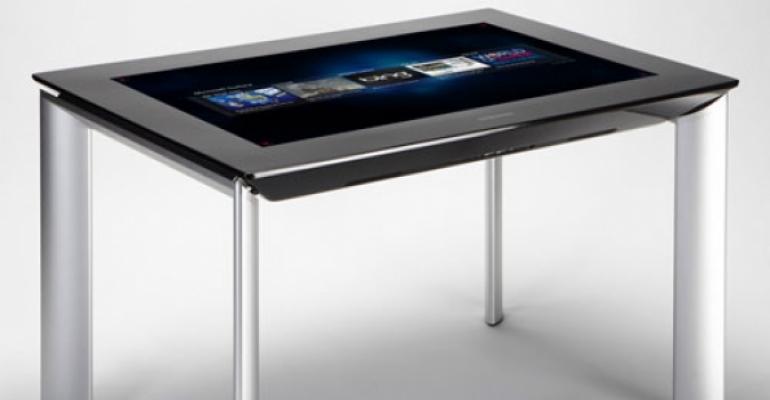A glimpse of a possible restaurant self-service and marketing technology was presented Thursday in Las Vegas where Microsoft Corp. and Samsung Electronics Co. Ltd. unveiled the latest generation of interactive Surface software and hardware.
The Sheraton hotel chain and Hard Rock Café's newest Las Vegas branch are among the hospitality users of first generation Surface technology. Sheraton has used Surface-powered tabletops for information distribution in lobby areas. At Hard Rock, multiple patrons can launch and navigate custom applications created by Hard Rock and Vertigo on a 30-inch display to “deep zoom,” or virtually tour the world to select a Hard Rock location, explore images on the exterior and interior of the chosen café, and then drill down through imagery and information tied to the memorabilia housed in that particular branch.
Sheraton has indicated it will incorporate Surface version 2 as part of its business and social connectivity initiative known as The Link @ Sheraton at selected hotels, Microsoft said.
At the massive Consumer Electronics Show in Las Vegas, Microsoft and Samsung officials presented Surface version 2, which, like version 1, permits multiple parties to simultaneously run software programs and manipulate digital content by touching the display.
Unlike the first generation of Surface, however, which required embedded cameras to provide information needed by the computer brain to process motion input before devising the appropriate on-screen response, the latest version detects and transmits data about user touch through Samsung’s new PixelSense LCD display technology.
“With the introduction of the next generation of Surface, using PixelSense technology, we’ll bring more tables and walls to life with amazing natural experiences for people to enjoy together,” Panos Panay, general manager for Microsoft Surface, said in a statement.
Microsoft and Samsung officials said the Samsung SUR40 touch-screen display technology will be available later this year in 23 countries, including the United States, and carry a suggested initial retail price of $7,600. They said the 40-inch diagonal, four-inch-thick device runs full high-definition imagery, with a 16:9 aspect ratio and 1920x1080 resolution. It incorporates for data processing and display purposes an embedded AMD Athlon II X2 Dual-Core Processor running at 2.9 gigahertz and AMD Radeon HD 6700 graphics processor supporting Microsoft DirectX 11 technology.
The latest Microsoft Surface software makes it possible for people to share, collaborate and explore together using a large, thin display that recognizes fingers, hands and other objects placed on the screen, according to Microsoft.
Industry pundits for years have talked about the possible future use of at-table interactive technologies to permit patrons to place their own orders, settle their tabs, view digital marketing materials, provide survey input, or collaborate on entertainment choices.
Some or all of those applications have been tested or deployed in foodservice settings.
T1 Visions’ touch-screen Connection tables are being used at the technology firm’s own T1 Tapas restaurant in Huntersville, N.C., and tabletop guest-self order and payment devices with entertainment options were used until earlier this year by branches of the now defunct uWink casual-dining group, whose TapCode division continues to market the technology.
Selected branches of some other chains, such as California Pizza Kitchen and Chili’s Grill & Bar, are testing or incorporating TableTop Media’s wireless touch-screen Ziosk devices, which market products and let guests settle their own tabs.
Brad Ludington of Keybanc Capital Markets Inc., wrote late last year that the Ziosk interactive technology being tested by the Los Angeles-based CPK has possible positive ramifications for the struggling casual-dining segment.
“We believe that the potential cost savings, positive impact on customer satisfaction, improved reads on new menu items and improved market research capabilities could not only help CPK, but could be a trend seen across multiple casual dining brands in the coming years,” Ludington said.
Contact Alan J. Liddle at [email protected].

